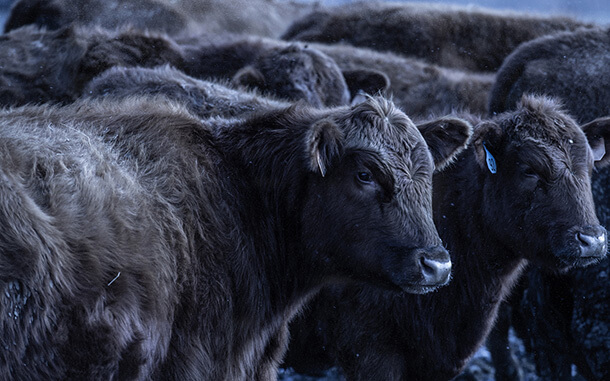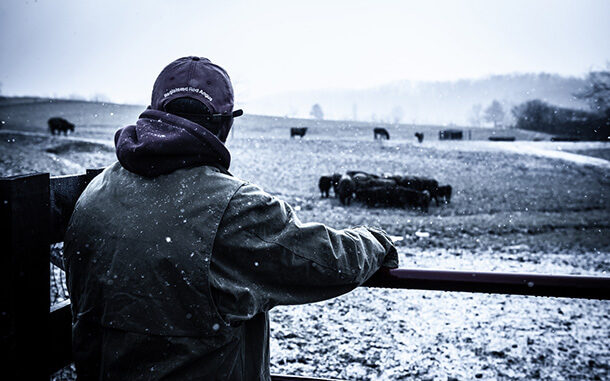Water is the Most Important Nutrient We Provide Cattle
“Although water is the cheapest nutrient we may purchase or provide, it is the one we provide the most of on a per pound basis,” said Ted Wiseman, extension educator for Ohio State University Extension Beef Team. “For example, every pound of dry matter consumed, cattle will need to drink about seven pounds of water. With colder temperatures feed intake is increased to generate body heat. Decreased water availability reduces feed intake which results in decreased body condition, poor fetal growth rates and lactation levels.”
It is crucial that cattle have access to fresh, clean water at all times. In general, cattle prefer water that ranges between 37 F to 65 F. The warmer you can keep the water in winter, the better. The rumen of cattle operates at roughly 102 F and ingesting very cold water can decrease digestion until the water warms up to body temperature.
Beef producers have utilized many water system designs over the decades, but quality automatic watering system tanks have consistently been proven over the years to help reduce maintenance costs and boost performance gains for your cattle.
“If given a choice of water sources cattle do prefer to drink from a tank instead of streams or ponds,” said Wiseman. “In a few studies that looked at this, cattle were given access to both with no restriction to stream or pond access. In both studies cattle preferred to drink from tanks 75 to 90 percent of the time.”

Prepare for Winter Before the Bitter Cold Sets In
Whether you have tanks that water one or one hundred head of cattle, there are some simple maintenance tasks you need to perform to keep your waterers operating at peak performance.
Step One: Clean Valve Chamber and Drinking Areas – Remove covers and use a brush or sponge to remove any debris that may have collected in trough areas and valve chambers. Pay special attention to the area where the immersion heater is housed. Deposits can build up on the heater if it is continuously stored in the waterer.
Step Two: Check All Water Seals – Quality automatic waterers, like those manufactured by Ritchie Industries, Inc., can utilize water seals using tracks intended to hold water or vegetable oil during cold weather which will freeze or seal the covers down onto the unit during the winter. If the tracks are full of debris or other materials, they won’t seal properly, and cold air may leak in and freeze your valve system.
Step Three: Inspect the All-Weather Sealant – Check the all-weather sealant around the base of the unit and the concrete pad to ensure no gaps have formed that would allow air to penetrate the underside of the unit. Replace if needed. Before winter, make sure to inspect inside the unit to make sure no critters have taken up residence or caused damage.
Step Four: Install & Inspect Optional Heating Units – Inspect all units for any damage. Plug in and turn on breaker to the immersion heater and/or heat cable after it is installed and under water. Chill the water with ice to activate the built-in thermostat. You can also test by placing your immersion heater in a freezer for 10-15 minutes and then plug it in without placing it in water. Either way, the heater should be warm to the touch within 15 seconds if it is working properly.
Units that have built in thermostatically controlled heaters can be tested by simply turning power on to the unit and filling the drinking areas with ice to activate the thermostats. If the ice melts away, your unit is operating properly.
Step Five: Troubleshoot Heating Elements – If your immersion heater is not becoming noticeably warm to the touch or if there is damage to the cord/wires, a new heater will be needed.
If the ice you poured in the thermostatically controlled drinking area of your unit does not melt away there are two main causes. If the ice melts on just one side of the unit, the heater of the opposite side may be malfunctioning, and needs replaced. If none of the ice melts, then your thermostat may need to be replaced or power to the unit is faulty. If you suspect an electrical issue, consult with an electrician.
Self-regulating cable heaters are low wattage and do not feel noticeably warm to the touch. You may need to test this with a voltage meter or ask assistance from an electrician. If this element goes out during the winter, you will notice that the drinking areas are free of ice, but you are not getting water from the valve.
Easy Water Solutions for Every Beef Producer This Winter
With a little maintenance and a solid winterization plan, you can keep the fresh water flowing this winter and keep your cattle growing and healthy. If you haven’t already invested in a quality waterer, there are many excellent options in the marketplace. Consistently the best-selling automatic cattle waterers are made by Ritchie Industries, Inc., the Iowa company that invented automatic waterers in 1921.
“There’s nothing worse than breaking ice or doing maintenance on a waterer when it is freezing outside,” said Robert Amundson, President and CEO at Ritchie Industries, Inc. “We offer a full line of durable, quality cattle founts that are cost effective, innovative and backed by the best warranty in the business. It is our mission at Ritchie to provide fresh water for life.”
For more information on Ritchie waterers, visit ritchiefount.com.








